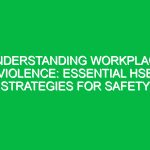Introduction
Hello, team! Today, we’re having a Toolbox Talk focused on a seasonal activity that many of us will encounter: **shoveling snow**. As we brace for winter weather, it’s essential to discuss the proper techniques and Safety considerations to keep ourselves and our coworkers safe during this physically demanding task. Whether it’s clearing pathways to ensure safe access or maintaining a workplace free from Hazards, understanding the Best Practices related to **shoveling snow** is crucial for our health and Safety.
The Importance of Safety in Shoveling Snow
Shoveling snow might seem straightforward, but it poses significant health risks. According to various studies, snow shoveling can lead to serious injuries, including musculoskeletal injuries, heart attacks, and slips and falls. These risks emphasize the importance of being proactive and educated about Safe Practices. In this Toolbox Talk, we will cover essential tips and techniques for **shoveling snow** efficiently and safely.
Understanding the Risks Associated with Shoveling Snow
Before diving into safety tips, let’s examine some of the Hazards related to **shoveling snow**:
- Physical Strain: Shoveling is a strenuous activity that can lead to overexertion and injuries, especially for individuals who are not regularly active.
- Cardiac Events: Sudden heart attacks can occur due to the intense physical effort involved in **shoveling snow**, particularly in those with pre-existing heart conditions.
- Slips and Falls: Icy surfaces can lead to slips and falls, resulting in injuries.
- Improper Techniques: Incorrect lifting and shoveling techniques can result in back injuries and other musculoskeletal problems.
It’s vital to recognize these risks and take steps to mitigate them.
Best Practices for Shoveling Snow
In the following sections, we will discuss several Best Practices to ensure safety when **shoveling snow**.
1. Prepare for the Task
Before you start shoveling, take a moment to prepare:
- Check the Weather: Assess the weather conditions before starting. If severe weather is forecasted, consider postponing the task.
- Dress Appropriately: Wear waterproof boots, insulated gloves, and layered clothing to stay warm and dry. Consider wearing a hat and goggles for additional protection.
- Stay Hydrated: Drink plenty of water before and during the task, as dehydration can increase the risk of injury.
2. Use the Right Tools
Choosing the right snow shovel can make a significant difference in your safety and efficiency:
- Choose the Right Shovel: Opt for a lightweight shovel with a curved handle to reduce the strain on your back. A shovel with a wide blade can help move larger amounts of snow.
- Consider Ergonomic Designs: Ergonomic shovels are designed to minimize stress on the body and can help reduce the risk of injury.
3. Use Proper Techniques
Employing proper techniques can significantly reduce the risk of injury:
- Lift with Your Legs: Bend at your knees and keep your back straight. Use your legs to lift the snow rather than your back.
- Push Instead of Lift: Whenever possible, push the snow instead of lifting it. This method reduces the strain on your back and arms.
- Take Breaks: Don’t try to clear everything at once. Take frequent breaks to rest and hydrate.
4. Be Mindful of Your Surroundings
Awareness of your Environment is critical when **shoveling snow**:
- Watch for Ice: Be cautious of icy patches that can contribute to slips and falls. Use salt or sand to create traction if needed.
- Clear Snow in Sections: Break the area into sections instead of doing everything at once. This method reduces fatigue and allows for more manageable shoveling.
5. Know Your Limits
It’s essential to listen to your body:
- Recognize Signs of Fatigue: If you feel fatigued, dizzy, or short of breath, stop immediately. Rest or seek assistance if necessary.
- Ask for Help: Don’t hesitate to ask a coworker for help if the snow is too heavy or if you are feeling unwell.
Real-Life Scenarios
Let’s consider a couple of hypothetical scenarios that illustrate the importance of safety when **shoveling snow**.
Scenario 1: The Overzealous Shoveler
Imagine an employee, John, who is eager to clear the parking lot quickly. He grabs a heavy shovel and tries to lift large heaps of snow all at once. After 15 minutes, he feels a sharp pain in his back and has to stop. John’s eagerness led him to neglect safety practices, resulting in a back injury that prevents him from working for weeks.
This scenario highlights the importance of using proper techniques, knowing your limits, and taking breaks during the task.
Scenario 2: The Icy Pathway
Sarah is shoveling snow from a walkway. As she clears the snow, she doesn’t notice that the underlying surface is icy. She slips and falls, resulting in a sprained wrist. If Sarah had taken a moment to check for ice and applied salt to the area beforehand, she could have avoided this injury.
These scenarios remind us of the potential dangers we face while **shoveling snow** and the importance of adhering to safety practices.
Regulations and Standards
Our company follows OSHA Regulations and guidelines regarding safety practices. It’s crucial to comply with these standards to ensure a safe working environment. In particular, the following regulations apply to snow removal:
- osha General Duty Clause: Employers are required to provide a workplace free from recognized hazards that can cause death or serious physical harm.
- Walking-Working Surfaces Standard: Employers must ensure that walking surfaces are free from hazards, including snow and ice, to prevent slips and falls.
Understanding these regulations helps us maintain compliance and fosters a safer work environment.
Conclusion
In summary, snow can be both a beautiful and dangerous aspect of winter. As we have discussed in this Toolbox Talk, **shoveling snow** requires proper preparation, the right tools, effective techniques, and awareness of our surroundings. Always be mindful of your physical limits and prioritize safety.
Thank you for your attention today, and remember that we all play a vital role in maintaining a safe workplace. If you have any questions or would like to discuss your experiences with **shoveling snow**, please feel free to share. Let’s work together to ensure we stay safe this winter!


